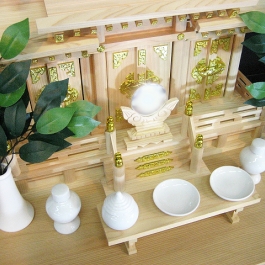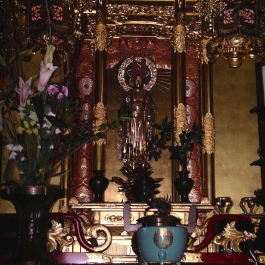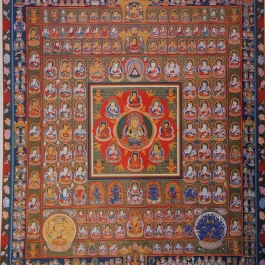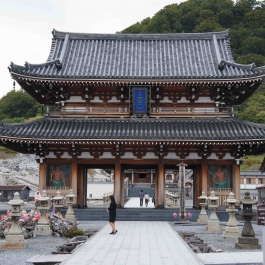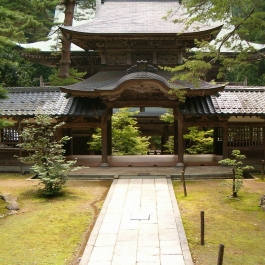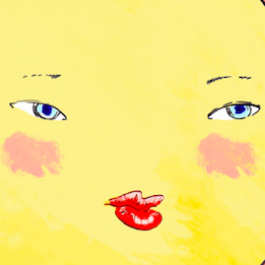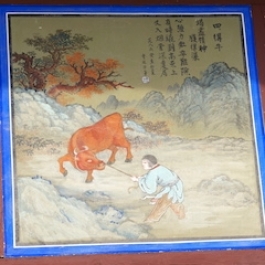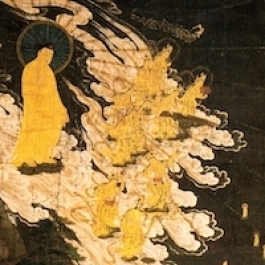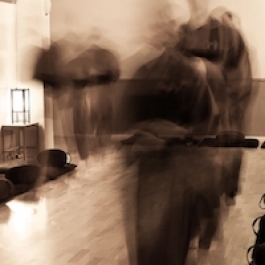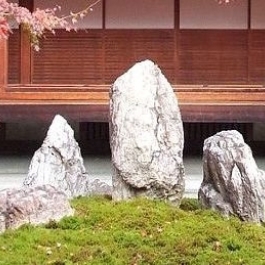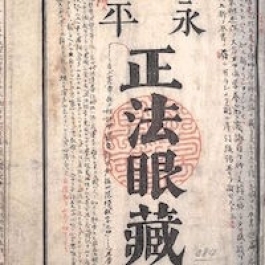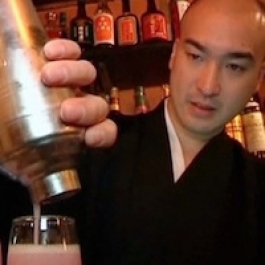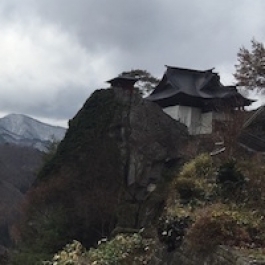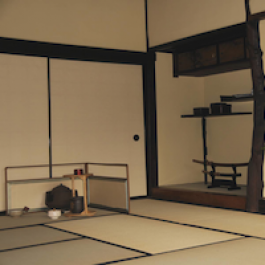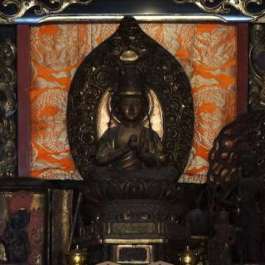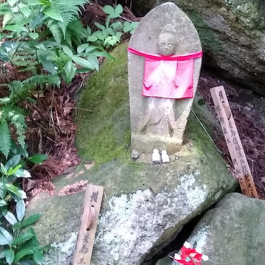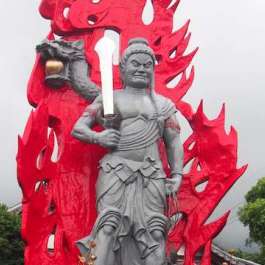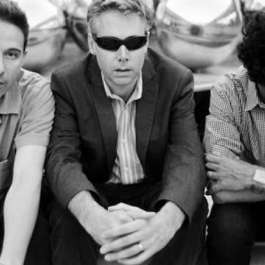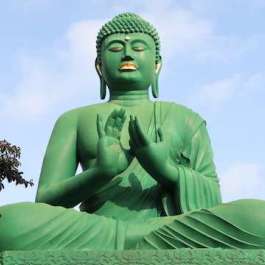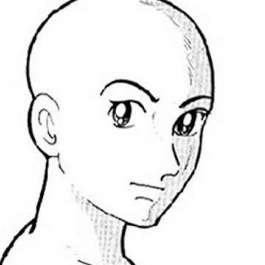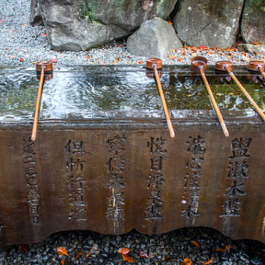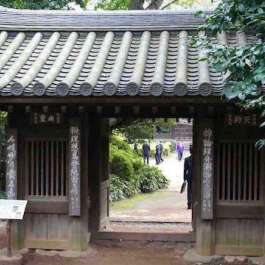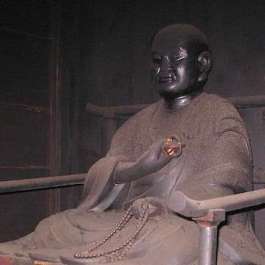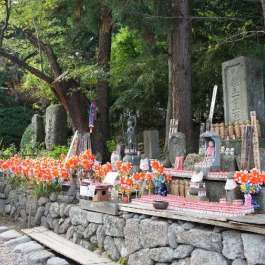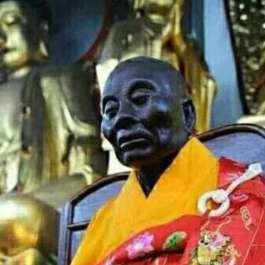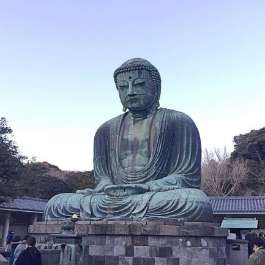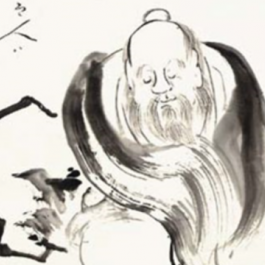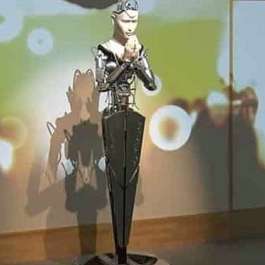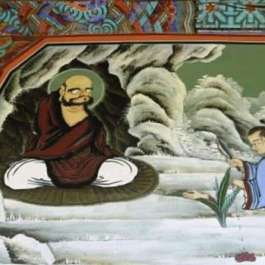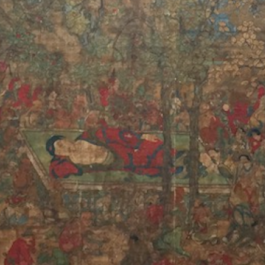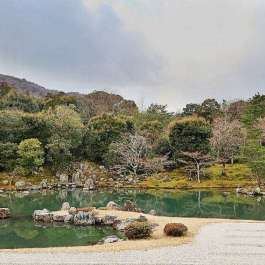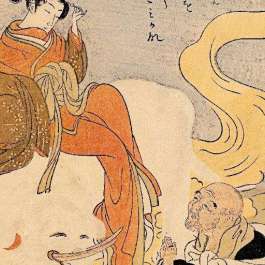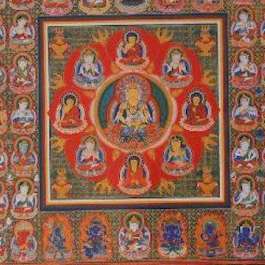Chapter 5 Kūkai’s Shingon Embodiment of Emptiness
John W. M. Krummel
The Oxford Handbook of JAPANESE PHILOSOPHY
====
Kūkai (774–8 35), the founder of Shingon (真言) Buddhism, was an important and influential figure in Japanese intellectual history. His philosophy is distinct in bringing together what initially seem to be concepts of opposite significance—body (shin 身, karada 体) and emptiness (kū 空). It does so in the context of formulating a complex system of cosmology-o ntology that is inseparable from religious practice. On the one hand, bodies are empty. But, on the other hand, emptiness is also the place for bodies and their interactions. And, in turn, that empty place is a cosmic body comprising a manifold of bodies. The cosmos is one giant empty body enfolding an infinity of empty bodies in its space. For Kūkai, the body is of central significance to one’s being vis-à - vis the world as the environing wherein of embodiment.
This is evident when examining his concepts of “becoming a buddha in this very body” (sokushinjōbutsu 即身成仏), “the embodiment of the dharma preaching the dharma” (hosshin seppō 法身説法), “the three mysteries” (sanmitsu 三密), and “empowerment and retention” (kaji 加持).
Through our bodies, we find ourselves implaced— embodied— within the world, in interactivity with the environment. We are who we are through our bodily interactions. But the cosmos is also a body that we, in turn, mirror as its microcosms, and this intermirroring between the individual qua microcosm and the cosmic whole qua macrocosm is played out via bodily interrelations.
In accordance with Mahāyāna philosophy, however, interactivity, intermirroring, interdependence precisely is the meaning of emptiness; that is, the lack of substantiality, the absence of ontological independence. Kūkai thus develops the formula taken from the Heart Sutra that “form is emptiness, emptiness is form” in a direction that involves the body qua empty body and embodied emptiness. Moreover, a third key factor that plays into this relationship between embodiment and emptiness for Kūkai is language, for the body is the medium for communicating this dharma—that is, the truth of emptiness in its nonduality with embodiment.
Of Kūkai’s theoretical works, the ones providing expositions of Shingon cosmology, including the significance of embodiment, are
- On Becoming a Buddha in This Very Body (Sokushinjōbutsugi);
- On the Meaning of Voice, Letter, and Reality (Shōjijissōgi); and
- On the Meaning of the Letter Hūṃ (Unjigi),
grouped together as the “Three Writings” (Sanbu- sho), all of which he composed in succession between 821 and 824.
The first text explicates the concept of sokushinjōbutsu. The latter two explicate the concept of hosshin seppō. All of these “Three Writings” in fact deal with the embodied realization of the dharma— the truth—but from different perspectives. In the following, I discuss the role that embodiment plays in Kūkai’s system and its relationship to emptiness as explicated mainly in these three works
Body
The concept of the body possesses a manifold and universal significance in Kūkai’s Buddhism. He explains the concept of the body (shin) in On Becoming a Buddha in This Very Body as referring to one’s own body, the bodies of other beings, sentient and otherwise. It can mean the entire cosmos as the “realm of the dharma” (Sk. Dharmadhātu; Jp. hokkai 法界), which in turn is identified as the body of the “Great Sun” Buddha (Sk. Mahāvairocana; Jp. Dainichi 大日) that personifies the “embodiment of the dharma” (Sk. Dharmakāya; Jp. hosshin 法身). The dharma (Jp. hō 法) here should be taken in the sense of the truth. It can also mean the various manifestations of this cosmic Buddha- body, the elements making up that cosmic body, as well as the various “bodies” involved in ritual practice symbolizing the dharma, such as the figures of Sanskrit letters (ji 字), the gestural symbols (in 印) of mudrās (Jp. ingei 印契; body-p ostures and hand- gestures), and maṇḍalas (Jp. mandara 曼荼羅; geometrical diagrams or patterns), as well as one’s expressive demeanor or countenance (gō 業). These senses are all interrelated to comprise one cosmic webwork that in itself is the body of the Buddha Dainichi as the embodiment of the dharma— a universal medium allowing for the concretization of universal enlightenment. Thus, in On the Meaning of Voice, Letter, and Reality, Kūkai cites lines from the Avatamsaka Sūtra that “all lands are in the body of the Buddha,” or that “each hair [of the Buddha] contains myriad lands as vast as oceans.” We might understand “body” then to mean the very “stuff” of the world and of reality in general, including one’s self. That bodiliness of reality here is not limited to the physical but encompasses the mental as well. But it cannot be reduced to the mind. Kūkai’s philosophy in this respect is distinct from the “mind-o nly” (Sk. vijñāpti- mātra; Jp. yuishiki 唯識) doctrine of the Yogācāra school of Buddhism. For Kūkai, the mental and the material are equally interpenetrating aspects of the dharma. His perspective is neither merely idealist nor merely materialist but takes a third standpoint that integrates the material and the mental or spiritual as all “body.”
The cosmos as such— as Dainichi’s body and as embodying the dharma—i s made up of six universal elements (rokudai 六大): five material elements (earth, water, fire, air/ wind, and space) and consciousness or mind. The Mahāvairocana sūtra (Jp. Dainichikyō 大日経) discusses the first five material elements, but to these Kūkai adds consciousness to underscore the nonduality of the material and the mental (shikishin funi 色心不
二). Their dynamic but harmonious interplay constitute the “timeless yoga” or samadhi (jō 定) of Dainichi’s body-a nd- mind. The cosmic body (i.e., “body-a nd- mind”) as such embraces every thing-e vent in the cosmos as composed of these elements, interfused in different ways. It takes the figure of a mandala. In other words, its pattern in shape and movement is represented in the mandalas used in Shingon ritual. The cosmos is a flowering of the dharma preached by Dainichi— this is the concept of “the embodiment of the dharma preaching the dharma” (hosshin seppō)— as it spreads out to beings receiving it in various degrees in accordance with their understanding. The mandala is the form this flowering takes. Correspondingly, the mind of the practitioner is also supposed to take on the form of a mandala through practice to realize its nonduality with the mandalic hosshin. In envisioning reality as a mandala, the practitioner realizes his own nature— in body and mind— as the Buddha existing in that mandalic reality and expressing itself in mandalic form. But this involves engagement of not the mind alone, but also of the body. All material bodies— each in its own way— manifest that cosmic embodiment of the dharma (hosshin). And it becomes manifest to greater degrees through one’s successful bodily practice and consequent enlightenment (i.e., “becoming Buddha”). Truth as such— the dharma— therefore cannot simply be what constitutes the mind alone. It comprises the material as well as the mental. It involves both mind and matter, knower and known, subject and object, as interdependent, nondual aspects of reality, always already encompassing and permeating everything, including the body- and- mind of each of us and constituting the body- and- mind of the Buddha Dainichi. In summary, Kūkai reveals the nondual reality behind three kinds of apparent duality: the duality within each of us (mind-b ody), the duality in our relations with other things (mind- matter, subject- object, self- other), and the duality in our relations with the very cosmos wherein we exist (individual- universe).
Our own bodies (bodies- and- minds) are thus dynamically interrelated with the cosmos as a whole. Microcosmos and macrocosmos touch and mirror one another via the body. Embodiment in this sense is the medium or vehicle of our implacement within the greater body that is the universe, mediating our relationship to everything else. The function of the hosshin is equated with all movements and change that occur in the cosmos. And, as Dainichi expresses the dharma through his movements, the cosmos is also the place for his sermonizing of the dharma; in other words, “the dharma- embodiment’s dharma- preaching” (hosshin seppō). Kūkai categorizes such cosmic alterations, the functions of the hosshin, in three ways in terms of visible form (e.g., loco-m otion or change of place and transformation or change in shape), the audible (sound), and the mental (the thinking process). Visible alterations are movements of Dainichi’s body, audible alterations are movements of Dainichi’s speech, and mental alterations are movements of Dainichi’s thoughts. Together they are called the “three mysteries” (sanmitsu). The “three mysteries” are at work in all thing- events and are ultimately nondualistic with the corresponding movements of ourselves. In being bodily, we take part in the living body of Dainichi, in its cosmic interplay. We are always already participating in its movements in our mental states and in our bodily actions. Implaced within the cosmos, our individual bodies as microcosmic mirrors of the macrocosm thus serve as locales for the self-m anifestation of the cosmic Buddha. The body as such, both microcosmically and macrocosmically, is no mere dead matter— Körper in German— but rather alive, Leib. Rather than the corporeal body, it means the embodied existence of body- and- mind as a dynamic whole, embodiment as life. And such lived and living embodiment makes the experiential verification of our Buddha- nature (busshō 佛性), its realization, possible.
It is this significance of embodiment that leads Kūkai to recognize the inseparability of theoria and praxis. Kūkai’s major contribution to Japanese Buddhism, which filled a lack in Nara Buddhism, was to bridge the gap between doctrine and practice. He provided a systematic rationale for the esoteric rituals and explained the connections between text, ritual, and icon previously left unexplained by the orthodox Nara schools. And he did this with his notion of embodiment in its multiple levels. On the basis of that theory, bodily praxis becomes essential for self-r ealization and, in this respect, possesses religious significance. Kūkai expresses this with his motto, “becoming a Buddha in this very body” (sokushinjōbutsu), which he explicates in On Becoming a Buddha in This Very Body. His claim is that the esoteric teachings of Shingon, as direct revelations from Dainichi himself expressing his enlightenment through the very “material” media of the world— hosshin seppō— enables the immediate realization of one’s own innate Buddhahood through one’s presently lived embodied existence. Kūkai here is referring to the Mahāyāna notion of “original enlightenment” (hongaku 本覚), the idea that all sentient beings have an original potential for enlightenment (Buddhahood) due to their inherent but unrealized Buddha- nature. But his understanding of enlightenment is distinct from what was taught in the orthodox Nara schools of Japanese Buddhism, according to which enlightenment involves a long and gradual process over countless eons of rebirths.
The idea of Buddha- nature goes back to the Mahāyāna doctrine of the tathāgatagarbha
(Jp. nyoraizō 如来藏), the “womb of the realizer of suchness.” But the garbha here that means “womb” can also mean “matrix,” as well as “embryo” or “seed.” As the seed or womb for realizing reality (hence, enlightenment), it signifies the universal potential for Buddhahood. But as a matrix, the womb could also mean the very cosmos wherein we evolve and grow toward enlightenment. As a seed, the tathāgatagarbha is within each of us, but as the cosmic womb or matrix, we are within it. Kūkai thus connects this essential ambiguity with the notion that the cosmos itself is the body of Dainichi that we mirror in our own bodies. By drawing out the implications, Kūkai can thus explicitly connect the doctrine of “original enlightenment” with embodied existence itself, involving the bodily reciprocity among Buddha, man, and cosmos. That is to say that the potential for enlightenment is within one’s own body, which in turn is the microcosmic embodiment or expression of cosmic enlightenment itself. But, as such, one is also within the cosmic embodiment of enlightenment, the living cosmic body of Dainichi. Kūkai expresses this reciprocity with the expression, “Buddha enters me and I enter Buddha” (nyūga ganyū 入我我入). As Dainichi preaches the dharma through all phenomena, we ourselves are the bodies through which this preaching takes place. This means precisely that we are enabled to realize the cosmic samadhi that our bodies-a nd- minds express. In this respect, the two exemplary concepts of Shingon Buddhism— hosshin seppō (“the embodiment of the dharma preaching the dharma”) and sokushinjōbutsu (“becoming a Buddha in this very body”)—a re nondual. The latter can then signify the realization of the universal Buddhahood of all beings, not only one’s self. In these manifold ways, Kūkai reworks the traditional Mahāyāna notion of inherent Buddhahood so as to underscore the bodiliness involved in the nonduality among Buddha, cosmos, and sentient being.
That significance of the body, then, underlies Kūkai’s prescriptions of specific forms of ritual behavior as the technē for realizing the intermirroring of microcosm and macrocosm, self and Buddha. The practice involves a “symbolic mimesis” of the three modalities of the cosmos, through the “three acts” (sangō 三業) of our own body, speech, and mind: taking on certain bodily postures (especially involving mudra-m aking ), engaging in specific oral- verbal utterances (mantra- incantations, dhāraṇī- recitations ), and performing certain mental exertions (including yoga, samādhi- concentration, maṇḍala- visualization). Thereby, Kūkai not only provides a coherent explanation of the relationship between theory and practice, but he also provides a concrete method for realizing through bodily experience original enlightenment. Kūkai’s elaborate system of ritual praxis underscores both the ontological and the epistemological significance of bodily interactivity with the environment and the nonduality between those ontological and epistemological senses. That is to say that in knowing through the body, one is through the body. The dharma reveals itself without end, but it is never unembodied, never without form, and hence we must realize this through our embodiment.
Emptiness
The body or materiality in general in Kūkai, however, cannot be understood in terms of substance. Rather, it must be underscored that the body for Kūkai—i nheriting the basic Mahāyāna concept of emptiness (Sk. śūnyatā; Jp. kū)— is empty of substantantility. Now the six elements comprising the cosmic body are said to be interdependent
(rokudai engi 六大縁起, “codependent origination of the six universals”) and mutually nonobstructing (rokudai muge 六大無礙, “nonobstruction amongst the six universals”). Each element, as a microcosm of the macrocosm, manifests the very truth embodied in the cosmos. That truth or dharma, one might say, is the “suchness” (Sk. tathatā; Jp. nyojitsu 如実) of their interdependent origination (engi 縁起), which had already been equated by the Chinese Huayan (Jp. Kegon 華厳) and Tiantai (Jp. Tendai 天台) Buddhists with the emptiness of all. Because each thing is relative to, dependent upon, contingent to other things, nothing is substantial; that is, nothing is ontologically independent. Rather, as dependent, everything is empty. And the very elements that constitute each thing are themselves empty. The entire cosmic web of interdependence and mutual nonobstruction then means a cosmic emptiness— the absence of any substantiality to guarantee permanence or stability. The cosmic body in this sense embodies the dharma qua emptiness, it is an embodiment of emptiness, an empty body. Moreover, that interdependence and mutual nonobstruction is not only horizontal, between the elements or bodies situated within the cosmos. It also obtains vertically between whole and part, Dainichi and beings. The whole is what it is in virtue of its parts, just as the parts are what they are in partaking of the whole. This entails microcosmic and macrocosmic correlativity. It is another way of putting the intermirroring of microcosmic and macrocosmic bodies. In mirroring each other, they are both equally as such and empty, desubstantialized and yet equally existing, and that is their dharma, the nonduality of suchness and emptiness. Although the hosshin is the embodiment of emptiness, it is nothing other than the physical, verbal, and mental forms of the cosmos. Through such radical relationality, Kūkai treads a middle path that avoids the reification of individuals as substances as well as their absorption into a universal totality as a cosmic substance. And through the nonduality of emptiness and suchness, he treads a middle path that precludes any sort of reification or hypostatization, on the one hand, as well as any kind of annihilation into utter nothingness on the other.
In this respect, a proper comprehension of Kūkai’s nonsubstantialism as designated in the Mahāyāna concept of emptiness is a key to understanding his notion of embodiment. The body is significant, yet not to be reified, whether human or cosmic, material or ideal, as monistic whole or as isolated monad. For it is formed only in its interrelations and, as such, is empty of substance. Embodiment entails the cosmic webwork of interrelations, in vertical and horizontal correlativity, on both micro and macro levels. And dependent origination in Mahāyāna thought means the emptiness of substantiality (ontological independence). So the embodiment of the truth in the cosmos— hosshin qua hokkai— signifies a universal emptiness that permeates that cosmic body. The cosmic body’s essence is this cosmic emptiness. And that emptiness, in addition, means “vast space” for its graph also signifies space.15 The ontological ground of all beings is an empty space, an unground, that engulfs all. The cosmic body in its endless vastness is a space embracing everything, a space of nonobstruction, allowing for their emergence without obstruction via interdependence. The cosmic body as empty is an open space permitting interrelationships with others, in contrast to being a self- enclosed monad or solidity. In its emptiness, it makes room for the myriad beings of the world. Within it, everything is equally empty. And each bodily being implaced within this cosmic body- place, as its microcosmic mirror, is likewise an empty place allowing for its nonobstructed interrelations with other beings and with the cosmos itself. The cosmic body comprising interdependent thing- events embodies the dharma qua emptiness. In virtue of this embodied emptiness or empty bodiliness, man and Buddha and cosmos are hence nondual. The dharmic truth of emptiness as such is embodied everywhere. It is not abstract but concrete, embodied, even if empty. It is not simply transcendent as the truth preached by Dainichi to the world. For it is, in fact, immanent to the very world, embodied in the world as its emptiness, the interdependent origination of its elements. Kūkai thus reads the Prajñāpāramitā Heart Sutra’s maxim, “form is emptiness, emptiness is form,” to mean the embodiment of emptiness or the body as empty. The dharma as such entails the nonduality of emptiness and embodiment, nothing and being. This acknowledgment of concrete embodiment on the one hand and emptiness on the other hand is in the spirit of Mahāyāna, which treads the middle path avoiding substantialism and nihilism.
Language
Kūkai’s theories of embodiment and emptiness cannot be divorced from his linguistic theory. Through the interdependent elements of the universe, the embodiment of truth,
15 The same Chinese character 空 is used to designate both “emptiness” and “space.”
the hosshin, personified in the Buddha Dainichi, is continuously omnipresencing everywhere. Kūkai characterizes this as the hosshin’s expounding of the dharma— hosshin seppō. In virtue of the omnipresence of the dharma, everyone has the inherent ability to recognize the universal Buddha- nature within. All phenomena are true expressions of universal emptiness. On this basis, we can realize our original enlightenment. Kūkai claims in his Treatise on the Difference Between Esoteric and Exoteric Teachings (Benkenmitsu nikkyōron) that his own “esoteric” brand of Buddhism is based directly on that dharma preached by Dainichi, a “sermon” that is happening through all phenomena, material and mental, through bodily, verbal, and mental media— configurations, resonances, and patterns—p ermeating the cosmos. That is to say that the sermon itself is the dynamic process involving the cosmos’ continual transformation. Kūkai explains how all thing-e vents serve as the “voice” of Dainichi’s preaching and as “letters” of his cosmic text. He expresses this in the term shōjijissō (声字実相) or “voice, letter, and reality,” which he explicates in his On the Meaning of Voice, Letter, and Reality (Shōjijissōgi). Shō (声), meaning “sound” or “voice,” is the breath of Dainichi, the vibrations of the five material elements in their interplay that resonate sounds through the air. Ji (字), meaning “sign,” “word,” “letter,” or “graph,” is sound in its signifying character as naming or meaning something. It provides the material base for fixing the sign’s distinction (shabetsu 差別) from other signs to specify its meaning. Every phenomenon of the cosmos, being empty of substantiality, is what it is through its interdependent origination. This also means that every thing— rocks, mountains, ants, and all— is what it is in mutual distinction with everything else. And this differentiation occurs vis- à- vis other thing-e vents in an endless chain of mutually referring (and differing) correlative thing- events. In reference to others and without substantial self- presence, each thing- event is hence empty. On this basis, all phenomena, as constituted by the intervibrations of the material elements and through their mutual distinctions, serve as letters of the cosmic (con)text, all signifying in different ways the dharma qua emptiness. The world itself, ordered into distinct and discrete things and events, thus emerges in the articulation of this dharmic text through mutual differentiations. And jissō (実相) means that “reality” is what is thus named, intended, meant, referred to, as evoked by shō becoming ji. The ultimate referent of the world as text is the dharma spontaneously embodied in the cosmos while serving as its source of reality and meaning.
The gist of Kūkai’s linguistic theory here is that the entirety of all beings is language, a symbolic expression of meaning in all things. The cosmos in that significance is the original cosmic body- text embodying the Dainichi- kyō (Mahāvairocana Sūtra), of which the Sanskrit text is only a derivative translation into human language. And the cosmos as such is one big cosmic mantra, as the monologue of the embodiment of the dharma— hosshin— preaching the dharma— hosshin seppō— of the suchness of things qua emptiness. In fact, it is an audiovisual text, a mantra in its significance and a mandala in its visual aspect. The mantra (shingon 真言) as used in Shingon practice symbolizes the vocalization of this cosmic sermon, immanent throughout the universe. The language of this cosmic text requires deciphering, and, depending on how one “reads” that text or “hears” its sermon, the language of the cosmos can guide one to enlightenment or deceive one into delusion. Its meaning can only be discerned through a religious practice that makes evident the dharma. Proper decipherment would involve the practitioner’s experiential realization of the Buddha’s threefold cosmic activities of body, speech, and mind— “the three mysteries” (sanmitsu)— through his own body, speech, and mind.
Kūkai further explicates the linguistic or mantric significance of the dharma in terms of “primal nonorigination” (or “originally unborn,” honpushō 本不生), as designated specifically by the Sanskrit letter A. By “nonorigination” (or “unborn”), he means the “nonarising” aspect of the perpetually “born” and co-a rising thing-events; that is, their emptiness and their differential referentiality that is without beginning or end. It is the origin of all in their ongoing and beginningless dependent origination— their “origin of no origin.” Each thing- event, as a sign referring to the rest of the cosmic text, mirroring the infinity of all other mutually referring and differing thing-e vents and their emptiness, points to that primal nonorigination of all. The writing of the cosmic text—a cosmogony qua cosmology— is not only ongoing but endless, continuously being reworked. Shingon ritual practice attempts to trigger the realization of that dharma through mantric pronunciations of Sanskrit syllables that emulate Dainichi’s utterance and attune the practitioner to the interresonance of the basic elements of the cosmos. Their incomprehension make explicit the materiality and dynamic process involved in the emergence of signs and undermines any linguistic assumption of the substantiality of things. But, of these syllables, it is the first Sanskrit letter, A, that for Kūkai specifically symbolizes that primal nonoriginating character of all being qua emptiness. A stands for the Sanskrit words for “origin” (ādi) and for “unborn” (anutpāda), combined in the Sanskrit ādyanutpāda (Jp. honpushō) or “primal nonorigination.” The mantra A (aji shingon 阿字真言), as “the mother of all sounds,” is thus taken to be the first sound uttered from Dainichi’s mouth. The Sanskrit A is also a prefix expressing negation, annihilation, and nothingness, that would undo reification into substances. But A is also the source of all sounds, as suggested by its being the first letter of the Sanskrit alphabet. For the absence of substantiality, emptiness, is precisely the interdependent origination of all. The negative here is also positive. A, in that respect, represents the nonduality of emptiness and form, nothingness and being, or, put differently, embodied emptiness, empty bodies. In symbolizing the nonoriginating emptiness that would undo any reification anywhere, A also means the original enlightenment of the embodiment of the dharma (hongaku hosshin 本覚法身)— the Buddha- nature pervading everywhere— that we ourselves, all sentient beings, are endowed with. This gives us hope for the realization of the enlightenment of all. These manifold meanings are all combined in Shingon’s mantric use of A to represent the primal vocalization of the hosshin.
Praxis
On the basis of the preceding discussion, we might summarize Kūkai’s philosophy with the basic point that the whole of being—t he entire cosmos—is a body that embodies the truth and is, at the same time, a text that communicates that truth. It is a body made up of manifold bodies that likewise embody that truth and that serve as letters or symbols of that truth. And that truth or dharma it embodies and communicates is its emptiness and suchness via its interdependent origination with its constituent bodies, the primal nonorigination of all in their interreferentiality that criss- crosses the vertical and the horizontal dimensions. Implaced within this cosmic body, which is in fact a dynamic webwork, participating in its movements, its articulations of the dharma, we are all endowed with the originally enlightened body of truth (hongaku hosshin). Buddhahood as such then is not something we achieve or attain, but that we rather realize as inherent to ourselves. This is the idea behind the Shingon practice of the “three acts” (sangō) of our body, speech, and mind—t aking certain bodily postures (e.g., mudra- making), engaging in specific oral-v erbal utterances (e.g., mantra-incantations), and performing certain mental exertions (yoga, samādhi- concentration, focusing on Sanskrit letters, mandala- visualization, etc.)— as a “symbolic mimesis” of the three cosmic modalities of the auditory, the visual, and the mental. Hence, “attaining Buddhahood in this very body” (sokushinjōbutsu) would mean precisely the realization of one’s inherent enlightenment through such bodily-a nd- mental mimesis, putting one’s own microcosmic body-a nd- mind in interresonance with the macrocosmic body- and- mind of the hosshin, to read correctly the cosmic text in its phonic, gestural, and graphic languages and discern the dharma. One thus realizes the empty mirror nature of one’s own body as embodying that dharma in mutual intermirroring with the “great mirror wisdom” of Dainichi, whereby “Buddha enters me and I enter Buddha” (nyūga ganyū). But if one can practice that “symbolic mimesis” in a natural setting, even outside of its usual ritualized context, “without form” (musō 無相) as opposed to “with form” (usō 有相), in one’s everyday movements, utterances, and thinking, one has come to truly spontaneously mirror the hosshin, realizing one’s nonduality with the truth one embodies. If the point of the practice of the “three acts” is to intentionally accord with, or interresonate with, Dainichi’s movements, to do the same unintentionally and spontaneously outside of the ritual context, but with the same awareness, would be an even higher level of realization.
Kūkai also expresses the dynamic correspondence between Buddha Dainichi and practitioner with the term kaji, meaning their “empowerment and retention.” The reference is to the mutual encounter between the Buddha’s compassion and the practitioner’s effort and aspiration. Ka (加), literally “addition” or “increase,” designates Dainichi’s compassionate power that pours down to illuminate like sunrays the practitioner’s mind. And ji (持), literally “retaining” or “holding,” designates the practitioner’s effort to retain and absorb that power like the illuminated water surface reflecting the sunlight. Shingon ritual bodily training is meant to express this bidirectionality, whereby the practitioner strives to ascend “upward” to meet Dainichi’s compassionate descent “downward.” The hosshin’s centrifugal preaching of the dharma (hosshin seppō) is to be met by the practitioner’s centripetal return to that dharmic source. As such, kaji also expresses the mutuality and correspondence obtained between hosshin seppō, descending from the summit and spreading out from the center, and sokushinjōbutsu, raising the practitioner from below and gravitating him toward the center, as two ways of conceiving from different angles the same interrelationality. But this is really a metaphorical way of expressing the single movement of intermirroring or interpermeation between the “three mysteries” (sanmitsu) of the macrocosmic body and the “three acts” (sangō) of the microcosmic body. That is, our own bodily, verbal, and mental activities are already expressions of the three mysteries of the hosshin. Kaji designates this realization that one’s self and activity is a microcosmic manifestation of the macrocosmic activity of the cosmos itself. In realizing the integration of the Buddha’s “three mysteries” and one’s own “three acts,” kaji entails an embodied and existential—r ather than merely intellectual— comprehension of the dharma, verifying the dharma the hosshin preaches in one’s own being. In Shingon praxis, one’s striving thus is the grace of the Buddha. The “always already” nonduality of these two directions of movement— up and down, centripetal and centrifugal, self-p ower and other-power—i s realized by degrees in en lightenment, whereby “Buddha enters me and I enter Buddha” (nyūga ganyū) and one “becomes Buddha.”28
Conclusion
In summary, both emptiness and embodiment mean for Kūkai neither a reifying realism, whether monistically or atomistically, nor an annihilating nihilism. The body, for Kūkai, both microcosmically and macrocosmically is empty in the following senses: (1) as a medium of interrelationality and interdependent origination; (2) as nonsubstantial,
28 See Kūkai 1972a, 230, 232; 1972b, 208, 212; 1983, 240–2 41, 245– 246; 1984, 26–2 7, 34.
without any self-c ontained essence that would obstruct its relations; and (3) as open and mutable, shaped through its interrelations. It cannot be reduced to mere material substantiality, but neither can it be reduced to a chimera of the mind. In this respect, he treads the Mahāyāna middle path that would avoid materialism on the one hand and idealism on the other. Moreover, that body, macrocosmically, is the text and, microcosmically, is the letters or signs communicating the meaning of that text, the dharma of emptiness that is the suchness of all. The universality of this embodied emptiness on both macrocosmic and microcosmic levels, mirroring one another, is what allows for the realization of this dharma; that is, for the realization of the nonduality between the preaching of the embodiment of the dharma (hosshin seppō), on the one hand, and one’s becoming enlightened in this very body (sokushin jōbutsu) on the other.
What relevance does Kūkai’s philosophy of the body as empty have for us today? Despite the common prejudice that would relegate Kūkai’s thinking to the realm of superstitious and magical religiosity, his thinking concerning embodiment and emptiness is in fact a wellspring of ideas that could be of interest to philosophers today. To recognize the fundamental significance of the body in its relation to the vaster body of the cosmos, both as living and lived rather than as dead matter, might open a vista to tackling the existential question of identity befalling contemporary humans in regard to their place in the world of difference and opposition. Miyasaka Yūshō, for example, regards Kūkai’s philosophy to be a “logic of integrative co- existence” (sōgōteki kyōson no ronri 綜合的共存の論理) that makes our multisided and comprehensive relationality evident, as opposed to a logic of power.29 It is precisely a standpoint of multisided integration that avoids the dichotomy of materialism and idealism and their mutual exclusion. Kūkai’s philosophy of embodied emptiness offers an alternative to the mind-b ody dualism that struggles to dislodge the self from the world or from the body. And it is also an alternative to the humans versus nature dualism that would set us apart from nature as its conqueror. The inadequacies of both types of dualism have already been made obvious by countless authors with the winding down of modernity. In showing our bodies to be ephemeral yet concrete media of intersection within the cosmic web, Kūkai’s thought can help turn us away from and provide an alternative to the hubris of modern subjectivity.
Bibliography and Suggested Readings
Abe, Ryūichi (1999). The Weaving of the Mantra: Kūkai and the Construction of Esoteric Buddhist Discourse. New York: Columbia University Press.
Gardiner, David (2008). “Metaphor and Mandala in Shingon Buddhist Theology,” Sophia: International Journal for Philosophy of Religion, Metaphysical Theology and Ethics 47(1): 43– 55.
Ingram, Paul O. (1993). “The Jeweled Net of Nature,” Process Studies 22(3): 134– 144.
29 Miyaska, Kūkai, 126.
Kasulis, Thomas (1988). “Truth Words: The Basis of Kūkai’s Theory of Interpretation.” In Buddhist Hermeneutics, edited by Donald S. Lopez, Jr. Honolulu: University of Hawaiʻi.
Kasulis, Thomas (1990). “Kūkai (774–8 35): Philosophizing in the Archaic.” In Myth and Philosophy, edited by Frank Reynolds and David Tracey. Albany, NY: SUNY Press, 257−272.
Kasulis, Thomas (1995). “Reality as Embodiment: An Analysis of Kūkai’s Sokushinjōbutsu and Hosshin Seppō.” In Religious Reflections on the Human Body, edited by Jane Marie Law. Bloomington: Indiana University Press, 166– 185.
Kasulis, Thomas (2000). “Kūkai.” In Concise Routledge Encyclopedia of Philosophy. London: Routledge.
Krummel, John W. M. (2010). “Kūkai.” In Stanford Encyclopedia of Philosophy. http:// plato. stanford.edu/ entries/ kukai/
Kūkai (1972a). Kūkai: Major Works Translated, with an Account of His Life and a Study of His Thought, translated by Yoshito Hakeda. New York: Columbia University Press.
Kūkai (1972b). “Kūkai’s Sokushin- jōbutsugi [Principle of Attaining Buddhahood with the Present Body],” translated by H. Inagaki. Asia Minor: A British Journal of Far Eastern Studies 17(2): 190– 215.
Kūkai (1973). Kōbō daishi Kūkai zenshū [Kōbō Daishi Kūkai Collected Works]. Vol. 1. Tokyo: Chikuma shobō.
Kūkai (1983). Kōbō daishi Kūkai zenshū [Kōbō Daishi Kūkai Collected Works]. Vol. 2. Tokyo: Chikuma shobō.
Kūkai (1984). Kōbō daishi Kūkai zenshū [Kōbō Daishi Kūkai Collected Works]. Vol. 4. Tokyo: Chikuma shobō.
Kūkai (1985). Sokushinjōbutsugi [Becoming a Buddha in This Very Body], translated into modern Japanese by Kanaoka Shūyō. Tokyo: Taiyō shuppan.
Kūkai (2004). On the Differences Between the Exoteric and Esoteric Teachings; The Meaning of Becoming a Buddha in This Very Body; The Meanings of Sound, Sign, and Reality; The Meanings of the Word Hûm; and The Precious Key to the Secret Treasury. In Shingon Texts, translated by Rolf W. Giebel. Berkeley, CA: Bukkyō Dendō Kyōkai and Numata Center for Buddhist Translation and Research.
Parkes, Graham (2013). “Kūkai and Dōgen as Exemplars of Ecological Engagement,” Journal of Japanese Philosophy 1: 85– 110.
Shaner, David Edward (1985). The Bodymind Experience in Japanese Buddhism: A Phenomenological Perspective of Kūkai and Dōgen. Albany, NY: SUNY Press.
Snodgrass, Adrian (1984– 86). “The Shingon Buddhist Doctrine of Interpenetration,” Religious Traditions: A Journal in the Study of Religion 7–9 : 53– 81.
Yamasaki, Taiko (1988). Shingon: Japanese Esoteric Buddhism, translated by Richard and Cynthia Peterson. Boston: Shambhala.






 Essays in Idleness and Hojoki (Penguin Classics)Essays in Idleness and Hojoki (Penguin Classics)
Essays in Idleness and Hojoki (Penguin Classics)Essays in Idleness and Hojoki (Penguin Classics) The 88 Temples of Shikoku: A Guide for the Walking PilgrimThe 88 Temples of Shikoku: A Guide for the Walking P…
The 88 Temples of Shikoku: A Guide for the Walking PilgrimThe 88 Temples of Shikoku: A Guide for the Walking P… Shingon Texts (BDK English Tripitaka)Shingon Texts (BDK English Tripitaka)
Shingon Texts (BDK English Tripitaka)Shingon Texts (BDK English Tripitaka) Moon In a Dewdrop: Writings of Zen Master DogenMoon In a Dewdrop: Writings of Zen Master Do…
Moon In a Dewdrop: Writings of Zen Master DogenMoon In a Dewdrop: Writings of Zen Master Do… Shingon: Japanese Esoteric BuddhismShingon: Japanese Esoteric Buddhism
Shingon: Japanese Esoteric BuddhismShingon: Japanese Esoteric Buddhism




